Amazon Kindle International Edition Review
Amazon Kindle International Edition
The Amazon Kindle is finally available in the UK, but was it worth the wait?
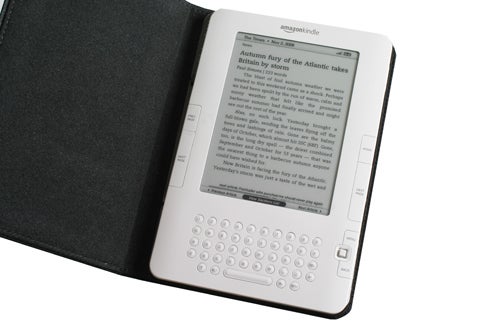
Verdict
Many people simply don’t get eBooks. The concept of wanting to read literature on an electronic device just seems, well, wrong to lovers of the written word, and to a certain degree I agree with them. I can’t imagine myself wanting to read a novel on a computer screen, a mobile phone or portable media player, but a proper eBook is a very different kind of device. In fact it wasn’t until I reviewed the Sony Reader PRS-505 that I fully appreciated the eBook, but once I’d spent some time with one, I was pretty much sold on the concept.
When it comes to eBooks, the Amazon Kindle is probably the most widely known and recognised, which is quite odd when you consider that until now it hasn’t been available outside the US. Finally though, after what seems like an age, the Kindle has been made available to us in the UK, but was it worth the wait?
First I should make it clear that the Kindle, in essence, still isn’t available in the UK, since amazon.co.uk doesn’t sell it. If you want to buy this International version of the Kindle, you need to order it from amazon.com in the US, from whence it shall be shipped to you. This means that you could end up paying duty and VAT on your Kindle if you’re unlucky enough to have your order stopped by customs. So, that $259 price tag could end up being a fair bit higher by the time you actually take delivery.
Of course this also means that you’ll have to pay for your Kindle in US Dollars, but then you’ll need to get used to seeing Dollar transactions on your credit card, because you’ll be buying all your books that way too. You see despite the fact that Kindle books are essentially just digital files, you can’t buy them from Amazon in the UK, instead you’ll have to order from the Kindle store in the US, and that means pricing in US Dollars.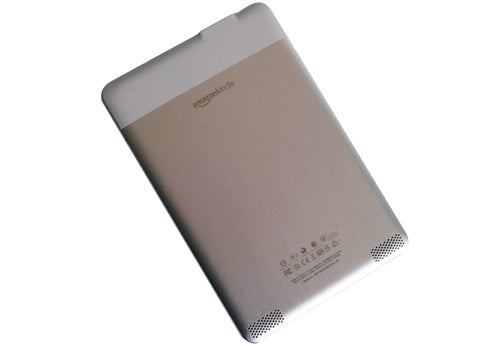
Assuming that you’re not charged too much for USD transactions by your credit card company, the fact that you’re buying from the store in the US shouldn’t be too much of a chore, because once you’ve set your Kindle up, you shouldn’t have to go to the Amazon website very often, if at all. Unlike other eBook readers, the Kindle doesn’t need to connect to a computer in order to have content loaded onto it. Instead, it has a built-in 3G data modem, which means that you can purchase and download anything from the Kindle store whenever, and wherever you want.
The 3G connection is, without a doubt, a fantastic feature – the ability to buy any book and have it delivered to you in seconds is quite compelling. So, if you happen to be chatting to someone on the train home and they recommend a book, you can buy that book and have it delivered to your Kindle instantly. It also means that if you finish a book, you can browse for something new to read straight away.
The wireless nature of the Kindle also lends itself well to periodicals. There’s something undeniably cool about picking up your Kindle and finding your preferred newspaper downloaded and ready to read – ideal for the morning commute. However, the experience isn’t everything it should be.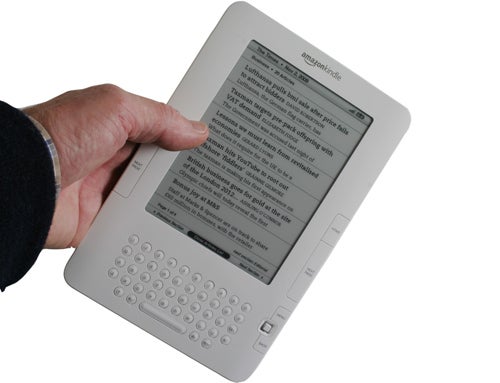
The problem with subscribing to newspapers or magazines is that you don’t get any pictures! Well, that’s not entirely true, US customers get pictures, but everyone else has to do without. What’s really galling about this situation is that even if you subscribe to a British publication like The Times (as I did), you still get no pictures. It’s fairly obvious that the reason behind this is that Amazon doesn’t want to stump up the data costs to deliver images outside the US, but it just highlights the fact that Amazon in the UK should be offering Kindle content to UK users.
Another issue with the US Kindle store is the limited catalogue, especially when you consider that it’s been up and running for a good couple of years now. The first book I searched for was The Catcher in the Rye, but all I was presented with was study guides on Salinger’s classic. Likewise, Harper Lee’s equally brilliant work, To Kill a Mockingbird is also conspicuous by its absence. 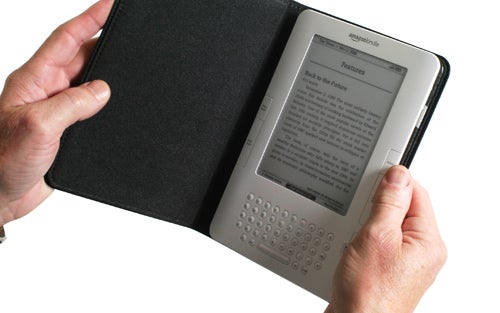
But even if you can find the book you’re looking for, the Kindle experience still isn’t all it should be. I decided to buy The Messiah’s Handbook by Richard Bach, which, if you’ve read any of Bach’s work, you’ll be aware that this is the book that Donald Shimoda gave to him in Illusions, but I digress. Despite the fact that the paperback version of this book cost around $7, and the hardback version cost under $10, the Kindle version set me back $13!
Considering that there are no printing costs, no shipping costs, and nothing physical to move in and out of stock, I can’t quite understand why the Kindle version of a book is more expensive than the hardback edition. I should be fair and mention that checking today, the Kindle price has dropped to the same level as the hardback, but it should still be cheaper.
To put the price issue into perspective though, I see the same thing in the music market. Often when I’m browsing CDs online, the physical CD is actually cheaper than the MP3 download, despite the fact that you can buy the CD and then rip it to your MP3 player anyway!
The Kindle model resembles digital music in another respect too, or at least Apple’s original incarnation of digital music. You see if you buy a Kindle, you will only be able to read books purchased from Amazon, despite the fact that there is a plethora of free eBook content out there. Of course, this is the whole point – the Kindle is basically a seeding device for Amazon’s Kindle store, in much the same way that the iPod was a seeding device for the iTunes store.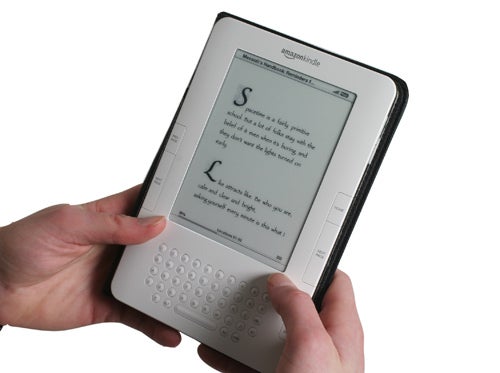
You can read PDF files on the Kindle with varying degrees of success, but you’re going to have to load them from your PC via the USB connector. You can email documents to your Kindle, but you’ll be charged a fee for the data transfer, so doing things the old fashioned way (with a cable) is preferable. That said, there aren’t too many PDFs that I’d be desperate to read on an eBook anyway.
There’s no denying that the Kindle hardware is very good indeed, and while the 6in screen may not be as large as that seen on the Sony readers, it’s still a beauty. Text looks razor sharp, and there’s no hint of reflection no matter what the lighting conditions. Also, images look truly superb, which makes the lack of illustrations in newspapers and magazines all the more lamentable. 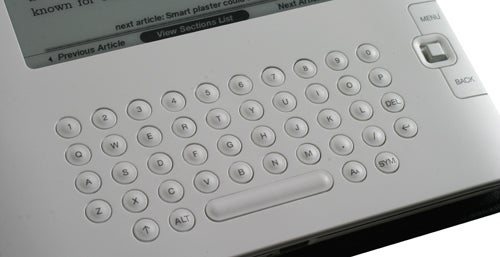
The keypad beneath the screen makes searching for books on the Kindle store a breeze. It also lends itself well to typing in URLs on the built-in web browser, or at least it would if that service was available in the UK. Unfortunately, despite the hardware supporting web browsing, Amazon has disabled the service outside of the US – another attempt to keep down data costs, no doubt.
Another reminder that you’re getting American hardware is the US power adapter that comes in the box – it’s a two prong affair that won’t work in the UK without a plug adapter. That said, it’s a USB adapter, so you can simply plug the supplied USB cable into your computer or any UK USB adapter that you have handy. 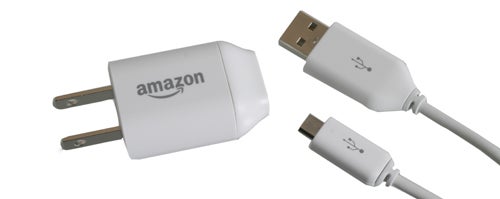
The Kindle comes with about 1.4GB of user accessible internal storage for your library of books, magazines and newspapers. According to Amazon, this equates to around 1,500 books, which is a decent amount of words by anyone’s standards. Even so, I still would have liked to have seen a memory card slot on the Kindle, especially since memory cards are so cheap these days.
With dimensions of 203 x 235 x 9mm and a weight of 289g, the Kindle is larger than the Sony PRS-505, and it weighs more than the touch-screen Sony PRS-600. It’s also worth mentioning that the leather cover that you see in the photos is an optional extra that will add another $20 to that price.
In use, the Kindle is pretty intuitive, with prominent Next Page buttons on both sides, along with buttons for the previous page, Home, Menu and Back. Navigation is performed via a tiny joystick, which works reasonably well, but can be temperamental at times. I can’t help thinking that a touch-screen interface would make things far easier, but I also know that I wouldn’t want that lovely screen covered in greasy finger marks. 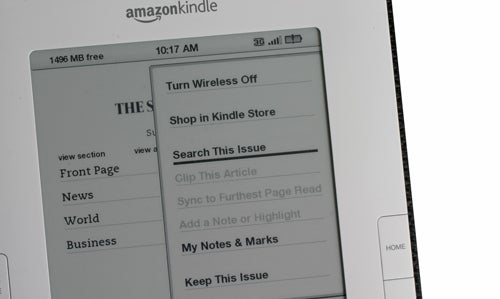
Battery life is good – in fact I’ve only had to recharge the Kindle once in the past two weeks, although I haven’t used it every day. But that’s the beauty of e-ink, once the page is drawn, the screen is then passive and draining no power from the battery. Of course the built-in 3G is probably the major drain on the battery, so it’s good to see that you can turn the wireless functionality off when you don’t need it.
There’s no doubt that the Kindle should be the best eBook reader on the market, but in reality, it’s not. What I should be looking at here is a proper UK, or at the very least, a European version of Amazon’s eBook, rather than a US version with international wireless functionality. I can’t help but feel that I’m being asked to make too many compromises because Amazon doesn’t want to commit to supplying the Kindle outside the US. 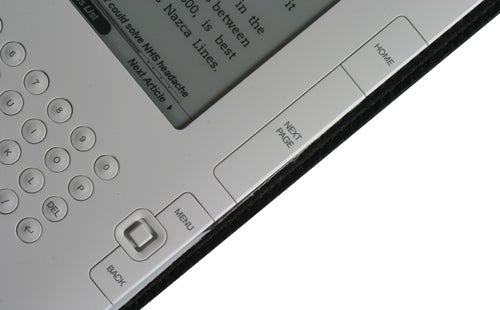
”’Verdict”’
Having waited so long for the Kindle to arrive in the UK I find myself somewhat underwhelmed by its arrival. The ability to buy a book and be reading it in seconds is, without a doubt, a fantastic feature, but it’s not enough. The need to order the Kindle from the US and pay for it in USD will be enough to put off some consumers, along with the need to continually buy books in USD from Amazon.com. Add to that the fact that the Kindle store is nowhere near as extensive as it should be, and the fact that you’re paying more for an electronic version of a book than you are for a hardback!
The idea of subscribing to periodicals is great, but the fact that anyone outside of the US won’t get any pictures in those publications, even if they are local to that reader, spoils what would otherwise be a superb feature. Then you’ve got the built-in web browser that also won’t work outside of the US, all of which goes to prove that this International edition of the Kindle is more about cashing in on foreign markets, rather than serving them.
But it’s the proprietary eBook format that really spoils the party for the Kindle. Because this device will only read eBooks purchased from Amazon, you’re missing out on a simply massive library of free literature that you could happily read on pretty much any other eBook reader. Perhaps if Amazon improves its available library of books and reduces the price, then this won’t be so much of an issue, but for now, it’s a deal breaker for me.
Trusted Score
Score in detail
-
Value 7
-
Features 8
-
Design 8

